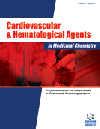- Home
- A-Z Publications
- Cardiovascular & Hematological Agents in Medicinal Chemistry (Formerly Current Medicinal Chemistry - Cardiovascular & Hematological Agents)
- Previous Issues
- Volume 7, Issue 1, 2009
Cardiovascular & Hematological Agents in Medicinal Chemistry (Formerly Current Medicinal Chemistry - Cardiovascular & Hematological Agents) - Volume 7, Issue 1, 2009
Volume 7, Issue 1, 2009
-
-
The Intermediate-Conductance Ca
More LessAuthors: D. L. Tharp and D. K. BowlesThe intermediate-conductance Ca2+-activated K+ channel (KCa3.1) was first described by Gardos in erythrocytes and later confirmed to play a significant role in T-cell activation and the immune response. More recently, KCa3.1 has been characterized in numerous cell types which contribute to the development of vascular disease, such as T-cells, Bcells, endothelial cells, fibroblasts, macrophages, and dedifferentiated smooth Read More
-
-
-
Current Status of Pharmacological Thrombolytic Therapy and Mechanical Thrombectomy for the Treatment of Acute Deep Venous Thrombosis
More LessAuthors: Thomas J. Kiernan, Beatriz Cepeda, Gareth D. Kiernan and Bryan P. YanDeep venous thrombosis (DVT) is a highly prevalent clinical problem associated with significant mortality and morbidity. In the United States alone, it is estimated that DVT affects approximately 50 per 100,000 people per year. This results in >600,000 inpatient and outpatient treatments per year and accounts for approximately 100,000 deaths from thromboembolic complications. Post-thrombotic syndrome (PTS) is associate Read More
-
-
-
Nucleotide-Derived Thrombin Inhibitors: A New Tool for an Old Issue
More LessAuthors: Stefano Lancellotti and Raimondo De CristofaroAptamer molecules represent an attractive approach in pharmacological therapy. Thrombin is a plasma serine protease that plays a key role in coagulation and haemostasis, also playing a relevant role in endothelial and smooth muscle cell functions. Thus, the development and use of direct thrombin inhibitors represents a potent tool in cardiovascular therapeutics. This review describes the status of direct thrombin inhibitors, Read More
-
-
-
Role of Natriuretic Peptide Family in Cardiovascular Medicine
More LessAuthors: Bibhuti B. Das and Robert SolingerThe natriuretic peptides (NP) are a group of structurally similar but genetically distinct peptides with many favorable physiological properties that have emerged as important candidates for development of diagnostic tools and therapeutic agents in cardiovascular diseases. The NP family includes atrial natriuretic peptide (ANP, 28AA), urodilatin (INN: Ularitide, 32 AA), B-type natriuretic peptide (BNP, 32AA), C-type natriureti Read More
-
-
-
Natriuretic Peptides in Cardiovascular Diseases of Fetus, Infants and Children
More LessAuthors: Bibhuti B. Das, Shashi Raj and Robert SolingerThe natriuretic peptides (NP) appear to be functional by midgestation, respond to volume stimuli, and regulate blood pressure and salt and water balance in the developing embryo. In addition, the NP may help regulate the blood supply to the fetus, acting as vasodilators in the placental vasculature. Peaks of ANP and BNP expression during gestation coincide with significant events in cardiac organogenesis, suggesting a r Read More
-
-
-
mTOR in Growth and Protection of Hypertrophying Myocardium
More LessIn response to an increased hemodynamic load, such as pressure or volume overload, cardiac hypertrophy ensues as an adaptive mechanism. Although hypertrophy initially maintains ventricular function, a yet undefined derailment in this process eventually leads to compromised function (decompensation) and eventually culminates in congestive heart failure (CHF). Therefore, determining the molecular signatures induced Read More
-
-
-
Antiarrhythmic Drug Therapy for Atrial Fibrillation: Focus on Atrial Selectivity and Safety
More LessAuthors: D. Li, H. Sun and P. LevesqueAtrial fibrillation (AF) is a highly prevalent arrhythmia and responsible for significant morbidity, mortality and health care cost. The prevalence of AF is expected to increase markedly with the aging population. The use of conventional antiarrhythmic agents has been limited by potentially fatal ventricular proarrhythmia. Rhythm control could become the preferred treatment strategy for AF if antiarrhythmic agents that are simil Read More
-
-
-
Inflammatory Cardiovascular Risk Markers in Obstructive Sleep Apnoea Syndrome
More LessAuthors: Silke Ryan and Walter T. McNicholasObstructive sleep apnoea syndrome (OSAS) represents a highly prevalent disease and is recognized as a major public health burden. Large-scale epidemiological studies have demonstrated an independent relationship between OSAS and various cardiovascular disorders. The pathogenesis of cardiovascular complications in OSAS is not completely understood, but given the complexity of the disorder, a multifactorial etiology is l Read More
-
-
-
Insights Into the Role of microRNAs in Cardiac Diseases: From Biological Signalling to Therapeutic Targets
More LessAuthors: E. Zorio, P. Medina, J. Rueda, J. M. Millan, M. A. Arnau, M. Beneyto, F. Marin, J. R. Gimeno, J. Osca, A. Salvador, F. Espana and A. EstellesmicroRNAs have recently opened new pathways to explain gene expression and disease biology in many scenarios, including cardiac diseases. microRNAs are endogenous small non-coding RNAs that mediate post-transcriptional repression or messenger RNA degradation. By annealing to inexactly complementary sequences in the 3' untranslated region of the target messenger RNA, protein level is down-regulated. Several Read More
-
Volumes & issues
-
Volume 23 (2025)
-
Volume 22 (2024)
-
Volume 21 (2023)
-
Volume 20 (2022)
-
Volume 19 (2021)
-
Volume 18 (2020)
-
Volume 2 (2020)
-
Volume 17 (2019)
-
Volume 16 (2018)
-
Volume 15 (2017)
-
Volume 14 (2016)
-
Volume 13 (2015)
-
Volume 12 (2014)
-
Volume 11 (2013)
-
Volume 10 (2012)
-
Volume 9 (2011)
-
Volume 8 (2010)
-
Volume 7 (2009)
-
Volume 6 (2008)
-
Volume 5 (2007)
-
Volume 4 (2006)
Most Read This Month
Article
content/journals/chamc
Journal
10
5
false
en


